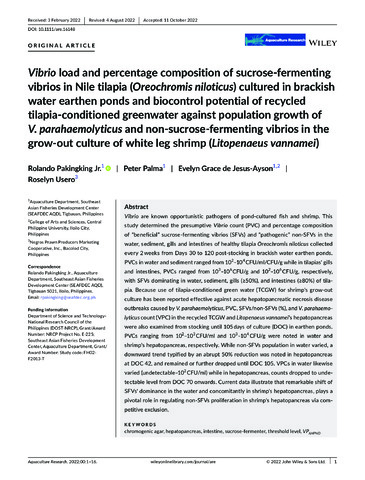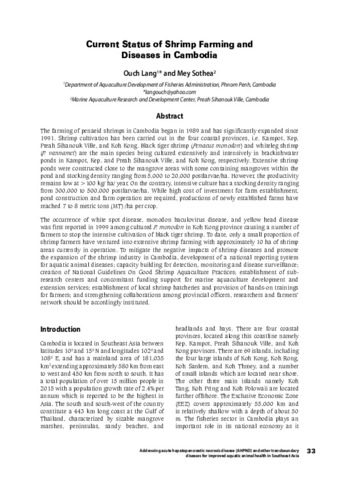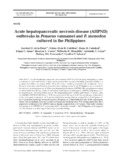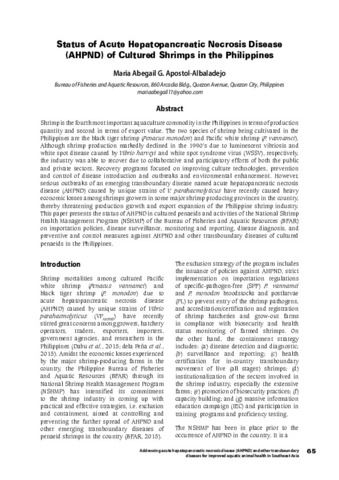Vibrio load and percentage composition of sucrose‐fermenting vibrios in Nile tilapia (Oreochromis niloticus) cultured in brackish water earthen ponds and biocontrol potential of recycled tilapia‐conditioned greenwater against population growth of V. parahaemolyticus and non‐sucrose‐fermenting vibrios in the grow‐out culture of white leg shrimp (Litopenaeus vannamei)
Share
Abstract
Vibrio are known opportunistic pathogens of pond-cultured fish and shrimp. This study determined the presumptive Vibrio count (PVC) and percentage composition of “beneficial” sucrose-fermenting vibrios (SFVs) and “pathogenic” non-SFVs in the water, sediment, gills and intestines of healthy tilapia Oreochromis niloticus collected every 2 weeks from Days 30 to 120 post-stocking in brackish water earthen ponds. PVCs in water and sediment ranged from 102–104 CFU/ml/CFU/g while in tilapias' gills and intestines, PVCs ranged from 103–106 CFU/g and 102–106 CFU/g, respectively, with SFVs dominating in water, sediment, gills (≥50%), and intestines (≥80%) of tilapia. Because use of tilapia-conditioned green water (TCGW) for shrimp's grow-out culture has been reported effective against acute hepatopancreatic necrosis disease outbreaks caused by V. parahaemolyticus, PVC, SFVs/non-SFVs (%), and V. parahaemolyticus count (VPC) in the recycled TCGW and Litopenaeus vannamei's hepatopancreas were also examined from stocking until 105 days of culture (DOC) in earthen ponds. PVCs ranging from 102–103 CFU/ml and 103–104 CFU/g were noted in water and shrimp's hepatopancreas, respectively. While non-SFVs population in water varied, a downward trend typified by an abrupt 50% reduction was noted in hepatopancreas at DOC 42, and remained or further dropped until DOC 105. VPCs in water likewise varied (undetectable–102 CFU/ml) while in hepatopancreas, counts dropped to undetectable level from DOC 70 onwards. Current data illustrate that remarkable shift of SFVs' dominance in the water and concomitantly in shrimp's hepatopancreas, plays a pivotal role in regulating non-SFVs proliferation in shrimp's hepatopancreas via competitive exclusion.
Suggested Citation
Pakingking, Jr., R., Palma, P., de Jesus‐Ayson, E. G., & Usero, R. (2022). Vibrio load and percentage composition of sucrose‐fermenting vibrios in Nile tilapia (Oreochromis niloticus) cultured in brackish water earthen ponds and biocontrol potential of recycled tilapia‐conditioned greenwater against population growth of V. parahaemolyticus and non‐sucrose‐fermenting vibrios in the grow‐out culture of white leg shrimp (Litopenaeus vannamei). Aquaculture Research, are.16148. https://doi.org/10.1111/are.16148
Subject
Taxonomic term
Collections
- AQD Journal Articles [1248]
Related items
Showing items related by title, author, creator and subject.
-
Current status of shrimp farming and diseases in Cambodia
Lang, Ouch; Sothea, Mey (Aquaculture Department, Southeast Asian Fisheries Development Center, 2016)The farming of penaeid shrimps in Cambodia began in 1989 and has significantly expanded since 1991. Shrimp cultivation has been carried out in the four coastal provinces, i.e. Kampot, Kep, Preah Sihanouk Ville, and Koh ... -
Acute hepatopancreatic necrosis disease (AHPND) outbreaks in Penaeus vannamei and P. monodon cultured in the Philippines
de la Peña, Leobert D.; Cabillon, Nikko Alvin R.; Catedral, Demy D.; Amar, Edgar C.; Usero, Roselyn C.; Monotilla, Wilberto D.; Calpe, Adelaida T.; Fernandez, Dalisay DG.; Saloma, Cynthia P. (Inter Research, 2015)Acute hepatopancreatic necrosis disease (AHPND) has recently emerged as a serious disease of cultured shrimp. It has also been described as early mortality syndrome (EMS) due to mass mortalities occurring within 20 to 30 ... -
Status of acute hepatopancreatic necrosis disease (AHPND) of cultured shrimps in the Philippines
Apostol-Albaladejo, Maria Abegail G. (Aquaculture Department, Southeast Asian Fisheries Development Center, 2016)Shrimp is the fourth most important aquaculture commodity in the Philippines in terms of production quantity and second in terms of export value. The two species of shrimp being cultivated in the Philippines are the black ...






